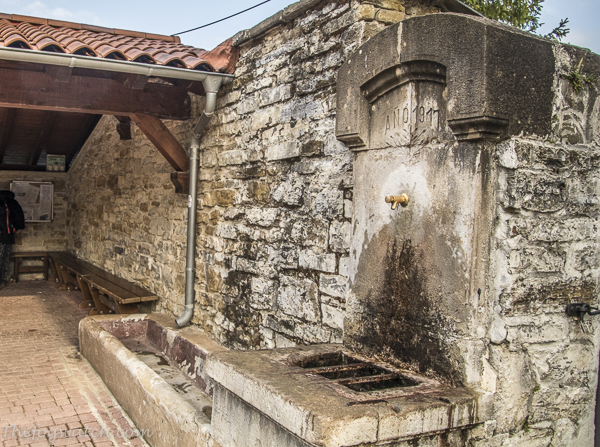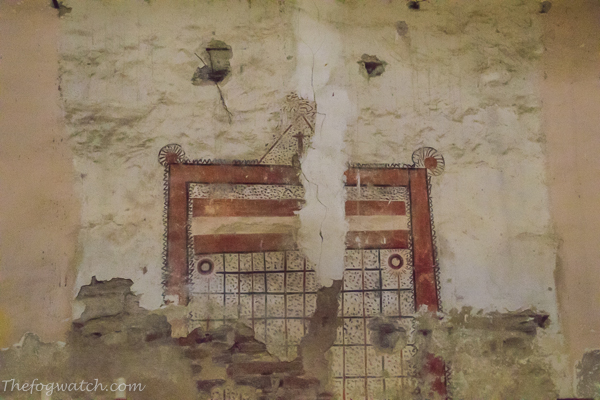Leaving Zubiri, we passed a noisy, dusty manganese processing plant, which supplies to the steel industry, including the arms factory down the road. Some people feel the sights and sounds of industry to be incompatible with the Camino.
In reality, industry has sat alongside the spiritual path for millennia. The Romans mined this area. Stone houses were built from locally quarried stone, indeed industry has been part of the human cultivation of this land since palaeolithic times. So for me, this is all part of the Camino. It is part of the human journey, as essential as bread, and shelter and of course the mindful path we take along this road.
I made a short video comment about this – click below to view it
Esteribar
Soon, however, we were back in the countryside and heading up to Esteribar – a well-kept hamlet with a wonderful pilgrim shelter and water fountain built in 1917. The water is potable and we refilled our bottles here after a short rest and some breakfast (bananas and a muesli bar).
The Abbey
Then a surprise highlight – we turned to descend the hill, and noticed an old building, perhaps a church, on the right. I stopped to take some photos and was hailed by the owner, who invited us in for a closer look.
It turned out to be the Abbey of Eskirotz and Ilarratz. And what a story he had to tell! Neill from South Africa was a pilgrim some years ago, who met his English wife Catherine in Madrid. Some time later, looking for a place to restore along the Camino trail, he found this church – long fallen into disrepair. It had been the C16th Church of St Lucia, but the history turned out to be far more interesting!
After a lengthy negotiation with the local Bishop and ultimately the Archbishop he gained permission to buy the building from the Diocese. Neill had had a lifetime career restoring old buildings in South Africa, and was not daunted by the state of the building. Working with art historians, he discovered C12th wall paintings behind the altar. And there were intriguing touches that revealed the building to have been originally a C12th fort of possibly Templar origin, converted to an abbey church in the C13th – the Abbey of Eskirotz and Ilarratz.
There were pre-Christian motifs incorporated into the wall painting – a sign this church was built in a period of transition in which local pagans were being brought into the Faith through symbolism, such as two sun designs and a myriad dots contained within squares – perhaps stars or souls.
“…the church’s hand-painted altar was dated as being from the mid-13th century (which was exposed after the church’s 16th century altar was stolen during the time it stood abandoned). The altar is apparently unique for the fact that it contains both Christian and Pagan symbols.”
It makes sense that the building was once a fort – perhaps a fortified house – at a time when the Order of Templars was established for the protection of pilgrims enroute to Jerusalem and to Santiago de Compostele. There would have been small forts and larger castles all along the route from this period. But with the disestablishment of the Templars, many of their properties were taken up by the hospitallers who cared for pilgrims’ more immediate needs for food and shelter.
It is Neill’s ambition that the Abbey will once again cater for pilgrims – in the form of accommodation in exchange for labour on the restoration project. It is Neill’s ‘Grand Design’.
This was a real highlight and well worth being a ‘slow pilgrim’ – Neill told us that he only came out to talk with pilgrims later in the morning, as the early birds are usually just out to make distance fast, the later ones made time to take in the environment around them.
I have the utmost respect for what Neill is trying to achieve here – and I look forward to seeing how it is going when we next pass this way – in about a year or two.
At length we took our leave and will treasure the stamp in our credential. Climbing the hill, crossing the medieval bridge we descended into Larrasoana and decided to stay there. At the supermercado (supermarket) we were again welcomed to Basque country before buying our bananas and retiring for beer and chips – and of course the washing…
________________________________________
INDEX – If you wish to follow our journey from the beginning, or jump in to any of the Camino posts,
here is a link to the index page – which can also be found in the navigation bar at the top of this blog
________________________________________








How I love this article! The Abbey was such a surprise and gem for me, and my visit there was one of the absolute highlights of my Camino. You have written this beautifully, and captured so much goodness about what this place is and stands for.
Thanks Elizabeth – it was a real surprise and gem for me too! I love that this piece of the Camino story is being restored and saved for future generations to enjoy 🙂
Funny that you mention the industrial side of the camino, it reminded me of a recent walk I did along the Monsal trail in the Peak District where I also came across an active quarry.
I’ve not seen this Abbey in anything I’ve read before, so will definitely look out for it next April.
Thank you for this lovely mention in your blog Jerry. It was an absolute pleasure meeting you and showing you The Abbey.
Anyone wanting to follow our adventure can find us on Facebook as: http://www.facebook.com/theabbey.es
I look forward to your return visit. Kind regards, Neill
Thank you Neill – I appreciate that you took the time out for us. You have a special building there full of history with particular meaning for the Camino and for pilgrims past, present and future. All the best! Cheers – Jerry
Hi Neill, you came out to chat with me last September.
I think it’s a marvellous thing that you’re doing there, it was really interesting to hear a little of the history of the abbey.
You suggested I call in at the Church of San Lorenzo in Pamplona when we got there. I did this but couldn’t get in to ask for the ‘special’ stamp. I was so disappointed, but hey ho, maybe next time.
I’ll be checking out your FB page for updates on the progress you’re making, I love to have the time to help out.
Colin
Hi Jerry, wonderful read. Looks like you and Sharon really took the time to experience and enjoy all of what the Camino provided to pilgrims to include these wonderful gems along the way.
Thanks Kathy – yes, and we feel we barely scratched the surface of what the Camino has to offer – of course we only get from the Camino what we put into it. It is certainly more than just a long walk 🙂
Such a fascinating story of the Abbey. No wonder you consider it a gem. The trek itself must be wonderful if you ae already planning a return trip.
I like the street, so clean and attractive too.
Thanks Maureen – yes the Camino presents wonderful surprises each day. The trek is indeed wonderful, though not easy, and yes we are certainly planning a return trip 🙂 The whole route is UNESCO World Heritage listed, so many of the towns are beautifully kept, although being rural areas, some are less well kept. But I think the real story of teh Camino is the people you meet along the way.
Thank you, Jerry, I am learning a lot from your posts.
I’m glad you’re enjoying them Anneliese 🙂 Every day we learned new things!